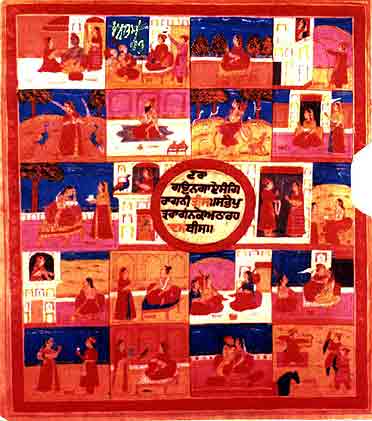Ragmala on:
[Wikipedia]
[Google]
[Amazon]
 Ragmala, Raagmala, or Ragamala ( Punjabi: ਰਾਗਮਾਲਾ ; pronounced rāgmālā) a composition of twelve verses, running into sixty lines that names various
Ragmala, Raagmala, or Ragamala ( Punjabi: ਰਾਗਮਾਲਾ ; pronounced rāgmālā) a composition of twelve verses, running into sixty lines that names various
Raag Mala in Punjabi, Hindi and English
{{Sikh Ragas Sikh terminology * Indian classical music Indian religious texts Indian music history Musical terminology
 Ragmala, Raagmala, or Ragamala ( Punjabi: ਰਾਗਮਾਲਾ ; pronounced rāgmālā) a composition of twelve verses, running into sixty lines that names various
Ragmala, Raagmala, or Ragamala ( Punjabi: ਰਾਗਮਾਲਾ ; pronounced rāgmālā) a composition of twelve verses, running into sixty lines that names various raga
A ''raga'' or ''raag'' (; also ''raaga'' or ''ragam''; ) is a melodic framework for improvisation in Indian classical music akin to a musical mode, melodic mode. The ''rāga'' is a unique and central feature of the classical Indian music tradit ...
s, which appears in most ''saroops'' of Sri Guru Granth Sahib
The Guru Granth Sahib ( pa, ਗੁਰੂ ਗ੍ਰੰਥ ਸਾਹਿਬ, ) is the central holy religious scripture of Sikhism, regarded by Sikhs as the final, sovereign and Guru Maneyo Granth, eternal Guru following the lineage of the Sikh gur ...
Ji after the compositions of Sri Guru Arjan Dev Ji entitled ''Mundaavani'' (ਮੁੰਦਾਵਣੀ; meaning "The Royal Seal").
The title literally means a 'garland of Ragas
A ''raga'' or ''raag'' (; also ''raaga'' or ''ragam''; ) is a melodic framework for improvisation in Indian classical music akin to a melodic mode. The ''rāga'' is a unique and central feature of the classical Indian music tradition, and as a ...
, or musical melodies'. "Mala" means "garland", while "Raga" is a "musical composition or mode", which has also given rise to the series of Ragamala paintings
Ragamala paintings are a form of Indian miniature painting, a set of illustrative paintings of the ''Ragamala'' or "Garland of Ragas", depicting variations of the Indian musical modes called ragas. They stand as a classical example of the amalg ...
. This list differs according to the author and the music school it is based upon. Thus there exists a number of such lists in the music text books of India.
Dividing issue on ragmala
There are eight raags that are utilised in Sri Guru Granth Sahib Ji that have not been mentioned in the Raagmala. These are: Bihagara, Wadahans, Manjh, Jaitsri, Ramkali, Tukhari, Prabhati and Jaijawanti. Mali-Gaura is not included in Raagmala but Gaura is. “The last pages of the Kartarpur Beerh do not suggest, either because of the presence of blank spaces, or scoring out, or obliteration hortal, or otherwise, that there was or could have been the least intention to write these hymns in the Granth. The Mudaavni is on page 973/1. Pages 973/2 and 974/1 are blank, and on page 974/2 is Raagmala. As such, there could never have been the possibility, nor could it ever have been contemplated that these three writings requiring a space of over four pages could have been accommodated on the two blank pages 973/2 and 974/1.” According to Dr. S. S. Kapoor, the Sikh scholars differ in their opinion about its inclusion in the Granth. The traditional school thinks it to be a part of Sri Granth Sahib Ji and asserts that it is an index of the raags used in Sri Granth Sahib Ji. This argument can be challenged on the grounds that a number of raags mentioned Raagmala are not in Sri Granth Sahib Ji and a number of raags used in Sri Granth Sahib Ji are not in the Raagmala. Another argument of the traditional schools that it is a part of the original copy and is written in the same ink and with the same pen as was used for the other parts of the Granth.Official Sikh standpoint on ragmala
Article XI (a) of the Sikh Rehat Maryada (SRM): "The reading of the whole Guru Granth Sahib (intermittent or non-stop) may be concluded with the reading of Mundawani alone or the Rag Mala according to the convention traditionally observed at all the concerned places. (''Since there is a difference of opinion within the Panth on this issue'', nobody should dare to write or print a copy of Sri Guru Granth Sahib Ji excluding the Raag Mala)."See also
*Ragamala paintings
Ragamala paintings are a form of Indian miniature painting, a set of illustrative paintings of the ''Ragamala'' or "Garland of Ragas", depicting variations of the Indian musical modes called ragas. They stand as a classical example of the amalg ...
* Sikh Raags
Further reading
1. Śabadārath Srī Gurū Granth Sāhib. Amritsar, 1964 2. Shamsher Singh Ashok. Rāgmālā Nirṇai. Amritsar, n.d. 3. Surindar Siṅgh Kohli. A Critical Study of Adi Granth. Delhi, 1961 4. Max Arthur Macauliffe. The Sikh Religion: Its Gurus, Sacred Writings and Authors. Oxford, 1909 5. Professor Sahib Singh. About the Compilation of Sri Guru Granth Sahib (Tr. Daljit Singh). Amritsar, 1996 6. Madan Singh. Raag Maala - A Re-appraisal in the Context of Sri Guru Granth Sahib Ji. Amritsar, 2003. 7. Taran Singh. Ragmala. The Encyclopaedia of Sikhism, Vol. III. Ed. Harbans Singh. Punjabi University, Patiala, 1997. P 426. 8. Kavi Santokh Singh. Sri Gur Partap Suraj Granth. https://web.archive.org/web/20080905180746/http://www.ik13.com/Rasses/SGPS%20Raas%203.pdfReferences
External links
Raag Mala in Punjabi, Hindi and English
{{Sikh Ragas Sikh terminology * Indian classical music Indian religious texts Indian music history Musical terminology